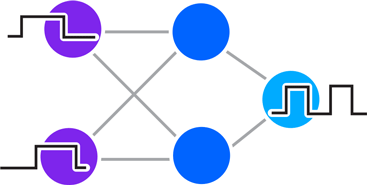Crossref Citations
This article has been cited by the following publications. This list is generated based on data provided by
Crossref.
Tuchman, Yaakov
Mangoma, Tanyaradzwa N.
Gkoupidenis, Paschalis
van de Burgt, Yoeri
John, Rohit Abraham
Mathews, Nripan
Shaheen, Sean E.
Daly, Ronan
Malliaras, George G.
and
Salleo, Alberto
2020.
Organic neuromorphic devices: Past, present, and future challenges.
MRS Bulletin,
Vol. 45,
Issue. 8,
p.
619.
Mirshojaeian Hosseini, Mohammad Javad
Donati, Elisa
Yokota, Tomoyuki
Lee, Sunghoon
Indiveri, Giacomo
Someya, Takao
and
Nawrocki, Robert A
2021.
Organic electronics Axon-Hillock neuromorphic circuit: towards biologically compatible, and physically flexible, integrate-and-fire spiking neural networks.
Journal of Physics D: Applied Physics,
Vol. 54,
Issue. 10,
p.
104004.
Sravya, V.
Pavithra, V.R.
Thangadurai, T. Daniel
Nataraj, D.
and
Kumar, N. Sathish
2022.
Excitation-independent and fluorescence-reversible N-GQD for picomolar detection of inhibitory neurotransmitter in milk samples ‒ an alleyway for possible neuromorphic computing application.
Talanta,
Vol. 239,
Issue. ,
p.
123132.
Massetti, Matteo
Zhang, Silan
Harikesh, Padinhare Cholakkal
Burtscher, Bernhard
Diacci, Chiara
Simon, Daniel T.
Liu, Xianjie
Fahlman, Mats
Tu, Deyu
Berggren, Magnus
and
Fabiano, Simone
2023.
Fully 3D-printed organic electrochemical transistors.
npj Flexible Electronics,
Vol. 7,
Issue. 1,
Deng, Yuping
Zhao, Mingyou
Ma, Yuan
Liu, Shangbin
Liu, Mingda
Shen, Boyu
Li, Rongfeng
Ding, He
Cheng, Huanyu
Sheng, Xing
Fu, Wangyang
Li, Zehui
Zhang, Milin
and
Yin, Lan
2023.
A Flexible and Biomimetic Olfactory Synapse with Gasotransmitter‐Mediated Plasticity.
Advanced Functional Materials,
Vol. 33,
Issue. 18,
Lei, Yuqiu
Li, Peiyun
Zheng, Yuting
and
Lei, Ting
2024.
Materials design and applications of n-type and ambipolar organic electrochemical transistors.
Materials Chemistry Frontiers,
Vol. 8,
Issue. 1,
p.
133.
Kadbe, Premanand K.
and
Markande, Shriram D.
2024.
Efficient Design of Reversible Adder and Multiplier Using Peres Gates.
Applied Sciences,
Vol. 14,
Issue. 20,
p.
9385.
Sun, Yimin
Lan, Yu
Luo, Jiali
Lu, Xiaokang
Lai, Yueping
Feng, Liang−Wen
Su, Ning
Chen, Jianhua
Huang, Wei
Li, Hongxiang
and
Ding, Junqiao
2024.
Backbone Engineering of Indacenodithiophene-Based Polymers for High-Performance Vertical Organic Electrochemical Transistors and Efficient Glucose Sensor.
Macromolecules,
Vol. 57,
Issue. 22,
p.
10835.
